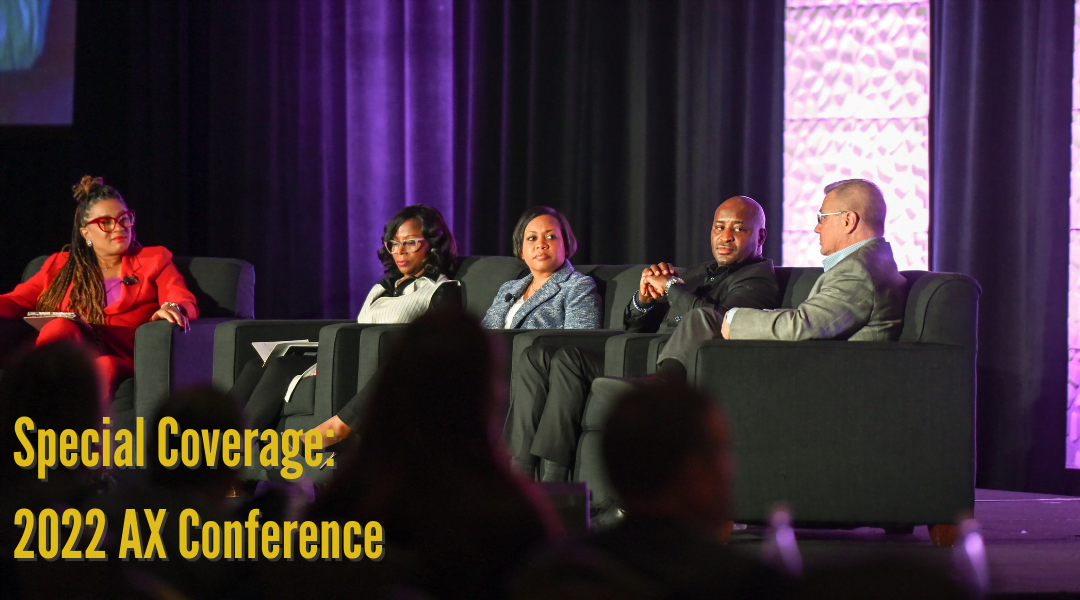SPECIAL COVERAGE: 2022 AX CONFERENCE
The topics of diversity, equity and inclusion came to the fore in 2020 with most major companies now equipped with a basic framework for addressing inclusion issues. Now that these are in place, how are companies and airports keeping up the momentum? How can they proactively engage with, support and empower their employees? The 2022 Airport Experience Conference gathered a panel of experts to address this complex issue and offer best practices.
Melissa K. Montes, publisher of Airport Experience News, served as moderator of the session, with panelists including Lynnwood Bibbens, chairman and CEO of ReachTV; Carol Gaddis, manager of guest relations for the Department of Aviation at Hartsfield-Jackson Atlanta International Airport (ATL) and vice chair of the Diversity, Equity & Inclusion Committee for the American Association of Airport Executives (AAAE); Mark Gale, CEO and director of aviation for Fort Lauderdale-Hollywood International Airport (FLL); and Nikki Harland, chief operating officer for Paradies Lagardère.
The session began with each panelist offering a look at where their companies are in their diversity, equity and inclusion (DEI) journeys. Gale first read from a report done by the Urban League of Broward County on the difference between equity and equality and that former—where people are offered varying levels of support based on their needs—is what we need to strive for. “Our commission has launched racial equity task forces and councils, but I think we still have a way to go.”
Bibbens noted that as the head of a private company, he has the ability to surround himself with many different voices, which has been beneficial to him and the company. “But two years ago we started to merge with another company and when I looked at that culture, it was the complete opposite of ours—so I’ve spent the last two years mentoring that company so we can blend our cultures,” he explained. “I think at the CEO level there have to be people who want to hear other voices. It has to be a change in the mindset from top to bottom, otherwise your programs will just stall.”
Harland spoke next and offered a sports analogy: “I think we’re in the first quarter still, where before we were pre-gaming,” she said. “At Paradies our culture and values have always been rooted in respect and trust and integrity, but we were never explicit about what we wanted to do. But today I’m so proud that we have a council that is made up of folks that represent all kinds of lives in different positions within the organization. We have the ideas, we have the targets, we are now in motion to actually make moves on the field.”
Gaddis drew attention to the fact that people with disabilities need to be included in conversations about DEI. “At Hartsfield-Jackson, we began that stakeholder engagement conversation looking at how long it would take someone with a disability to go terminal to terminal,” she said. “We brought in advocacy groups to work on this and consequently our entire terminal-to-terminal fleet of transportation has been changed to accommodate individuals with disabilities. It’s all of these kinds of things that we have to take into consideration.”
The conversation then shifted to what can be done to keep DEI programs evolving so they can become core to companies rather than something extra or a box to check. Gale pointed out how much representation matters, and that it needs to go all the way to the top. “I took a look at our numbers recently and 46 percent of my workforce is Black, but as it gets into the higher levels, you see those numbers dwindle, and that’s where we start to realize that we’re not achieving as best we can,” he said, adding that almost 50 percent of his workforce is age 50 or older and only six percent are between the ages of 20 and 29. “I look at this as an opportunity—we need to seize this moment and craft internal programs on mentorship and training.”
There are many ways organizations can focus their efforts on recruitment of more diverse staff. Gaddis noted that the executives she works with in her role with AAAE have partnered with area schools to look into mentorship and scholarship opportunities to open the door for young diverse people to enter the industry. Bibbens called attention to an advocacy group he’s a part of called Black and Brilliant, which helps place Black CEOs throughout companies. And Harland pointed out, “We have a staffing shortage right now—shame on us if we don’t diversify within our organization as we’re out on the street looking for people.”
Gaddis urged organizations to look into their hiring practices. “Do your employees really see themselves in stages of growth in the organization, because there’s a clear understanding of what it takes to grow, or do they plateau because they don’t know that there’s something else?” she asked. “That’s where you need to look at the intentional action plan that sets the tone for how the organization functions from the time you enter to the time you choose to depart. Do they have the big picture?”
And even with implementation, there has to be constant monitoring to ensure the success of these initiatives and goals, Gaddis added. “It can’t just be something that you shoot out of the gate and hope hits the target, otherwise we’re back to square one, just kicking the ball around on the field,” she said. And while the panelists agreed that there probably won’t be a point where we “win” and solve all of these issues, things will get better. “We’ll begin to reflect the communities that we serve, we’ll begin to see individuals compete in the marketplace in a fair and equitable manner,” Harland said. “There are things that we’ll see along the way that will confirm that we’re going in the right direction.”






